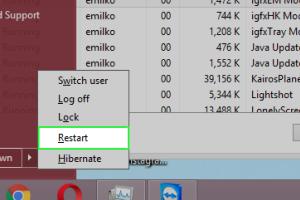Mastering the Art of Closing a Dialog Box: A Comprehensive Guide

-
Quick Links:
- 1. Understanding Dialog Boxes
- 2. Common Types of Dialog Boxes
- 3. Why Closing a Dialog Box Matters
- 4. Methods to Close a Dialog Box
- 5. Step-by-Step Guide to Closing Dialog Boxes
- 6. Troubleshooting Common Issues
- 7. Expert Insights and Case Studies
- 8. Best Practices for User Experience
- 9. FAQs
1. Understanding Dialog Boxes
Dialog boxes are small windows that prompt the user to input information or make decisions. They are essential components in software applications, providing a way to communicate with users regarding actions that need to be taken.
2. Common Types of Dialog Boxes
There are various types of dialog boxes, including:
- Modal Dialog Boxes: These require users to interact before they can return to the main application.
- Modeless Dialog Boxes: Users can interact with other windows in the application while this box is open.
- Alert Dialog Boxes: These notify users of important information or errors.
- Confirmation Dialog Boxes: These ask for user confirmation before proceeding with an action.
3. Why Closing a Dialog Box Matters
Closing dialog boxes properly is crucial for maintaining a smooth user experience. It can affect application flow, user satisfaction, and overall efficiency.
4. Methods to Close a Dialog Box
Here’s how users can close a dialog box:
- Clicking the 'X' button
- Pressing the 'Escape' key
- Clicking 'Cancel' or 'Close' buttons within the dialog
- Using keyboard shortcuts (e.g., Alt + F4 on Windows)
5. Step-by-Step Guide to Closing Dialog Boxes
Here’s a detailed guide to closing dialog boxes across different operating systems and applications:
5.1 Closing Dialog Boxes on Windows
- Locate the dialog box on your screen.
- Identify the 'X' button in the top right corner.
- Alternatively, press 'Escape' on your keyboard.
5.2 Closing Dialog Boxes on macOS
- Find the dialog box on your screen.
- Click the red circle in the upper left corner.
- Or, press 'Command + W' to close the dialog.
5.3 Closing Dialog Boxes in Web Browsers
- Click outside the dialog box if it's a modal.
- Press 'Escape' if the dialog is designed to close with it.
6. Troubleshooting Common Issues
Sometimes, dialog boxes may not close as expected. Here are some common issues and solutions:
- Dialog Box Freezing: If a dialog box becomes unresponsive, try using the Task Manager (Windows) or Force Quit (macOS).
- Dialog Box Not Appearing: Check if it’s behind other windows or if the application needs to be restarted.
7. Expert Insights and Case Studies
According to a study by Nielsen Norman Group, simplifying dialog box interfaces can significantly enhance user engagement. Companies that optimized their dialog box designs saw a 30% increase in user satisfaction.
8. Best Practices for User Experience
To improve the user experience while dealing with dialog boxes:
- Ensure clear labeling of buttons.
- Minimize modal dialogs to avoid interrupting user workflow.
- Provide alternative ways to close dialog boxes.
FAQs
1. What is a dialog box?
A dialog box is a small window that prompts the user for a response or provides information.
2. How can I close a dialog box without a mouse?
You can usually close a dialog box by pressing the 'Escape' key or using specific keyboard shortcuts.
3. What if the dialog box is unresponsive?
If a dialog box is unresponsive, try using Task Manager (Windows) or Force Quit (macOS) to close the application.
4. Are all dialog boxes modal?
No, dialog boxes can be modal or modeless. Modal dialog boxes require interaction before you can return to the main application.
5. Why do some applications have confirmation dialog boxes?
Confirmation dialog boxes are used to prevent accidental actions by asking for user confirmation.
6. Can I customize dialog boxes in software development?
Yes, developers can customize dialog boxes to fit the needs of their application and enhance user experience.
7. What happens if I close a dialog box without saving?
If you close a dialog box without saving, any unsaved changes may be lost, depending on the application.
8. How can I prevent dialog boxes from appearing?
Check application settings; some applications allow you to disable certain dialog boxes.
9. Are there keyboard shortcuts for closing dialog boxes?
Yes, common shortcuts include 'Escape' or 'Alt + F4' on Windows and 'Command + W' on macOS.
10. Can dialog boxes be helpful?
Yes, they can provide essential notifications and requests for user input, improving interaction with the application.
Conclusion
Closing a dialog box is a fundamental skill for users of any software. Understanding the different types of dialog boxes and knowing how to navigate them can significantly enhance your productivity and user experience.